Poison Mushroom Removal

Sgt. Poopers provides weekly poison mushroom control to remove toxic fungus.
Contents (Quick Links)
Man-Made Mushroom Explosion
Mushroom-Control Protocol
Poison Mushroom Facts
How Experts Identify Mushrooms Species
Emergency Poison-Control Hotlines
Mushroom Poisoning, Symptoms in Dogs
MOST DANGEROUS SPECIES IN DALLAS, TX
Amanita Phalloides, Death Cap
Conocybe apala
Amanita virosa, Destroying Angel
Chlorophyllum molybdites, False Parasol
Galerina Marginata, Autumn Galerina
Amanita Muscaria, Fly Agaric
Amanita Gemmata, Jeweled Death Cap
Inocybe Stellatospora
Clitocybe Dealbata
NON-DEADLY SPECIES IN DALLAS, TX
Phycomyces Blakesleeanus
Tricholomopsis Rutilans, Plums and Custard
Pisolithus Tinctorius, Dyemaker's Puffball
Hymenopellis Furfuracea
Pricing
Summary
Poison Mushroom Introduction
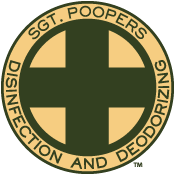
Dallas backyards commonly host several species of highly-toxic mushrooms which can appear overnight. Ingesting any of these poisonous fungi (loosely called "mushrooms") can not only make a human or dog severely sick, eating just one bite can result in irreversible damage to vital organs and even death. Sgt. Poopers can help protect your family and pets by finding and removing suspicious mushrooms each week when we clean. Prices start at just $1.95 for weekly customers.
EMERGENCY INFORMATION CLICK HERE
There are more than 10,000 types of mushrooms. It is nearly impossible to tell the toxic ones from benign ones because many look exactly alike. Do not eat wild mushrooms! Symptoms may not show up for hours and by then it may be too late!
- Remove any suspicious mushrooms each time we clean
- Inspect lawn, beds, mulch, and rock gardens
- We take pictures to document fungal growth
- Removal method is manual
- No toxic chemicals
- The only effective way to handle the threat
- More frequent inspections give greater safety
Man-Made Mushroom Explosion:
The Unforeseen Consequence of Automatic Irrigation
A population boom of mushrooms is an unintended byproduct of irrigation systems that keep laws green all year... and soaking wet! The threat is compounded by the fact that some of these mushrooms smell and look "appetizing" to dogs and children both of whom lack any internal mechanism to restrain the urge to eat what smells and looks good. In the wild, if a creature eats a toxic mushroom and dies, the decomposition of their carcass releases a bonanza of nutrients into the soil for spurring more fungal growth. So killing people and animals is a fungal survival mechanism and not haphazard. It is indeed a cockeyed world where death is often the price of survival. Anytime your dog seems mysteriously ill, it's not a bad idea to check your yard for toxic mushrooms. But bear in mind, there are millions of varieties of fungi, of which about 250 species are known to be toxic or even deadly.
Mushroom-Control Protocol
 Mushroom proliferation caused by human impact is another arena where our unique mission of conservation — managing human impact on land and water — brings a solution. We are not advocates against human impact or irrigation. We simply keep the consequences under control so things don't get too crazy. By narrowing our focus on just conservation, we are able to provide our services at a price literally anyone can afford. Add our Poison Mushroom Control to your service, and we will remove mushrooms, toadstools, puff balls, stink horns, etc., from your backyard each time we clean.
Mushroom proliferation caused by human impact is another arena where our unique mission of conservation — managing human impact on land and water — brings a solution. We are not advocates against human impact or irrigation. We simply keep the consequences under control so things don't get too crazy. By narrowing our focus on just conservation, we are able to provide our services at a price literally anyone can afford. Add our Poison Mushroom Control to your service, and we will remove mushrooms, toadstools, puff balls, stink horns, etc., from your backyard each time we clean.
Mushroom of varying types grow all year. So we simply remove any "fruiting bodies" (mushrooms) that are suspicious. The few species that grow on dog waste get removed automatically, but those aren't usually toxic.
Poison Mushroom Facts
Poison mushrooms must be removed before your dog eats them. Some species have a fishy odor that is appetizing to dogs. To be on the safe side, veterinarians and poison control authorities usually assume any mushrooms potentially toxic to pets unless they are able to quickly identify the culprit as benign.
- Some mushrooms contain enough toxins to kill a healthy adult with just one bite
- Symptoms may not appear for hours; by then, the toxins can already be absorbed
- Once the toxin is absorbed, the destruction of liver and kidney tissue may be irreversible
- Fungal poisioning may be more common than we know since even mycologists (fungi scientists) know relatively little about these mysterious organisms that are neither plant nor animal
 Complicating their toxicity is the fact that some fungi species seem benign in some areas and toxic in other areas
Complicating their toxicity is the fact that some fungi species seem benign in some areas and toxic in other areas- Some people have a strong toxic effect, while other people seem to be more immune
- Mushroom toxicity is affected by the proximity of other nearby plants and trees since many species are mycorrhizal, meaning they exchange nutrients with tree roots in a mutually beneficial relationship; this gives them uniquely variable toxic chemical properties
- Individual toxic reactions are also affected by the state of health of the victim — people or dogs with frail constitutions may experience a much worse reaction than those in strong physical shape
- Look-alike mushrooms are deceiving. Mushroom appearance can vary from place to place.
- Cooking doesn't make them safe!
- Just breathing in the aroma of a toxic mushroom being cooked can poison you!
- Even "safe" wild mushrooms can cause unpleasant reactions in people who are sensitive
The best plan is to keep kids and pets away from all wild fungus, mushrooms, mold, and toadstools. If you think your pet has eaten a mushroom, call your vet immediately.
How Experts Identify Mushrooms Species
It is unsafe and generally IMPOSSIBLE to really identify a particular mushroom species without very close inspection, chemical tests, and microscopic examination. Differentiating factors include,
- color, shape, texture and translucence of the cap
- shape of gills or pores under the cap including how and whether they attach to the stalk
- color of the spores — requires performing a "spore test"
- shape, color and texture of the stalk
- whether the stalk changes color when bruised or cut
- shape, color and texture of the base under the dirt
- how the cap is attached to the stalk
- whether it grows by itself, as a cluster, or in a circle or semi-circle
- what the mushroom is growing on or near — dog waste, certain trees, rotting logs or stumps, etc
- how it smells
- chemical reaction (requires chemical reactants)
- microscopic structure (requires a microscope)
Emergency Poison Control Contact Information
What do you do if you have eaten a poison mushroom?
HUMAN: If you or a child has eaten a wild mushroom, immediately contact your doctor, the nearest emergency room, or the Poison Control Hotline at (800) 222-1222. Save a sample if you can for expert identification.
Handling toxic fungi is not recommended, but in most cases, if you merely touch a poison mushroom, nothing will happen.
What do you do if your Dog eats a poison mushroom?
PET: If you know or suspect your pet has eaten a mushroom, immediately contact your veterinarian, the nearest emergency animal clinic, or the 24/7 Pet Poison Helpline at (855) 764-7661. If your pet subsequently throws up or poops, collect a sample, place it in a plastic bag and bring it with you.
Mushroom Poisoning, Symptoms in Dogs
The sooner you act, the cheaper treatment may be, so don't wait.
- Vomiting
- Diarrhea
- Abdominal pain
- Loss of coordination
- Lethargy
- Tremors or seizures
- Uncontrolled drooling
- Collapse or coma
- Organ failure
MOST DANGEROUS FUNGUS SPECIES in Dallas, Texas
Infants and toddlers, like dogs, commonly taste and/or eat things they find in their environment. This practice, called grazing, can put them in harms way if mushrooms are about.
Simple descriptions and photographs cannot teach which mushrooms are safe because so many species look almost exactly alike. As conservationists, we advocate respect for nature. "Respect" teaches us to treat any gun like it's loaded and to assume any mushroom is deadly. NEVER EAT ANY WILD MUSHROOM!
Here's a list of fungi we see commonly in Dallas backyards.
Amanita Phalloides, "Death Cap," DEADLY!

"Amanita phalloides. Piacenza's mountains" by is licensed under CC BY-SA 3.0
Sometimes a mushroom’s name says it all. This ordinary-looking 'shroom has provided more fatal mushroom poisonings in people and pets than any other. One reason, is that it does resemble several edible species. While the Death Cap is most common in Europe, today it is also found throughout North America, especially where European species of oak, chestnut and pine have been imported over the decades. It was found as early as 1918 in California. And by the 1970s it was found across North America.
We look for them during the summer and autumn seasons. As you can see from the photo, the white cap usually feature a greenish tinge, supported by a white stalk and gills, but this is not always the case. All-white versions have been found.
Consumption of the death cap is a medical emergency requiring immediate hospitalization. Just a single fresh mushroom contains enough toxin to visit agonizing death upon two fully-grown adults. Perhaps an even lesser amounts could kill your dog. The group of poisons, called Amatoxins, are "thermostable" which means is they are unaffected by cooking, freezing or drying. These toxins create massive damage to the liver and kidneys, so often leaving transplantation as the only means to avert death.
Any assumption that poisonous mushrooms signal danger by the way they look or taste is false! The few people who have eaten a Death Cap and somehow survived, report the taste to be good.
When fresh, they have a sweet sell, like honey. Affected people animals will start to exhibit severe gastrointestinal distress some hours after ingestion. These severe symptoms lessen after about three days leading some victims to think they are in the clear... but not. The most severe consequences start at about four days — kidney and liver failure. Death usually comes between six to sixteen days after the mushroom was eaten.
Conocybe apala (same toxin as death cap) deadly!

Poisonous Conocybe found at a Sgt. Poopers client's home in Dallas, Texas 6/20/19. Photo by Steve Hall.
Conocybe species can not only be hallucinogenic, they may contain the same deadly toxin as the Death Cap so they must not be consumed. We see these small, fragile toadstools all the time in Dallas yards from spring to fall. Shockingly, they represent a clear and present danger to small children and dogs who might accidentally eat one, perhaps while "grazing." For this reason, any Conocybe mushrooms should be removed immediately from your lawn.
These toadstools are so frail, the sun's heat may cause them to collapse. But realize this type of toxin is not affected by drying and continues to be deadly.
They can be recognized by their small fluted conical cap, pale color, fringy bottoms, gills pale to light brown, and their weak, slender stem.
Sgt. Poopers can rid your yard of these mushrooms and protect your pets.
Amanita virosa, Destroying Angel, DEADLY!

"Amanita virosa" by Mike Ostry, U.S. Forest Service, from
Field Guide to Common Macrofungi in Eastern Forests and Their Ecosystem Functions
The Destroying Angel did not earn its name by accident; this is one of the most lethal mushrooms in the world with the same class of toxins as the Death Cap. It is also mycorrhizal, exchanging vital nutrients with tree roots in a mutually beneficial relationship. But it may also grow on lawns and grassy meadows near trees or shrubs from summer through fall.
It is somewhat recognizable by its smooth white cap, gills, veil, and stalk on a rounded base. But as with all mushrooms look-alikes exist. In fact, the Destroying Angel is a good example of why attempting to identifying mushrooms by their appearance alone is foolhardy in the extreme. Its white spores are about the only thing that distinguishes this deadly species from benign ones!
Chlorophyllum molybdites, False Parasol, Vomiter, Poisonous

Poisonous Chlorophyllum molybdites mushrooms growing in Sgt. Poopers client's home in Dallas, Texas 8/15/18. Photo by Steve Hall.
Chlorophyllum molybdites or the False Parasol is also called the Vomiter, for good reason. This highly poisonous schroom responsible for more cases of accidental poisoning than any other mushroom. Luckily, it is not known to be fatal. A pet or human ingesting this one will experience severe gastrointestinal symptoms of vomiting and diarrhea. It is very similar-looking to edible mushrooms and tends to grow near human habitation.
Galerina Marginata, "Autumn Galerina," DEADLY!
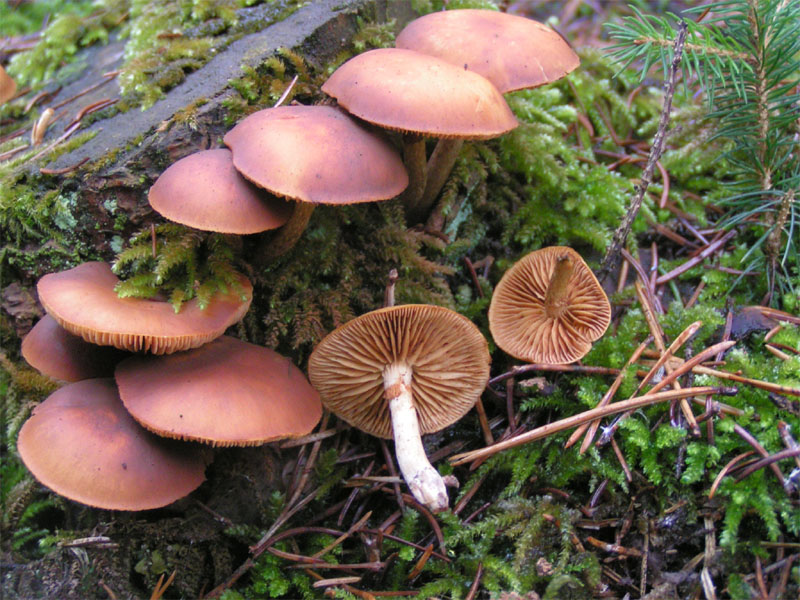
"Galerina Marginata" by Eric Steinert is licensed under CC BY-SA 3.0
Galerina is a small, extremely poisonous brown or reddish brown toadstool that can be found in Dallas, Texas. If eaten by a human or pet, it can cause severe liver damage and death if not treated rapidly. Like the infamous Death Cap (see below), it contains deadly compounds called amatoxins which are lethal in small doses. Even eating half a mushroom can kill a human or dog. Cooking does not affect its poisonous nature.
Symptoms include violent cramps, vomiting, diarrhea, and hypothermia. A human or animal who has eaten one of these mushrooms experience a false recovery on about the third day, and will then relapse into a more dangerous condition. Without treatment, the toxic effect brings severe damage to the liver, kidneys and heart, followed by coma or death.
Sgt. Poopers can watch for toxic fungi like Galerina Marginata throughout the year.
Amanita Muscaria, "Fly Agaric," DEADLY!
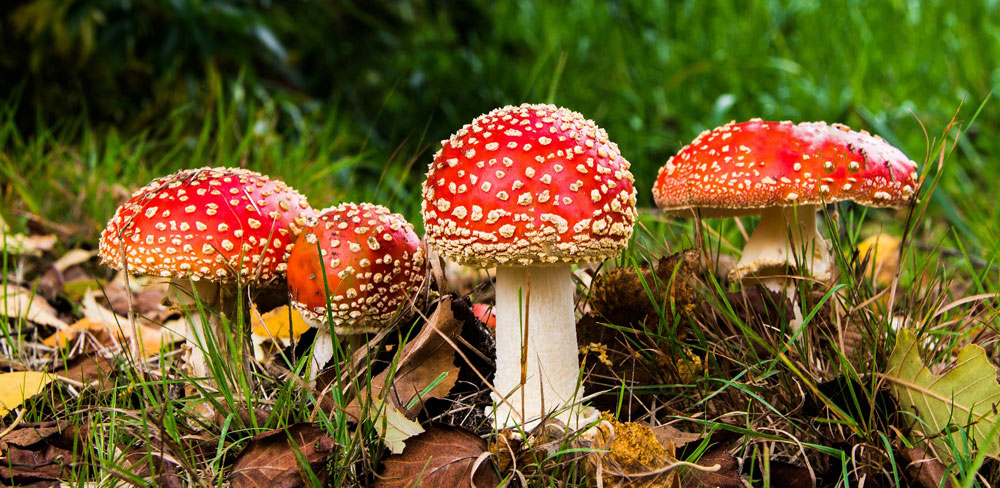
Photo by Gary Cowles from FreeImages
To many people around the world, the white-flecked bright-red cap of the Amanita Muscaria mushroom is the textbook example of a lethal toadstool. Common throughout North America, it is generally found in wooded areas but can also be found in yards. In older times, the mushroom was dried and broken into small pieces that were soaked in water or milk to poison house flies.
Amanita Gemmata, "Jeweled Death Cap," DEADLY!
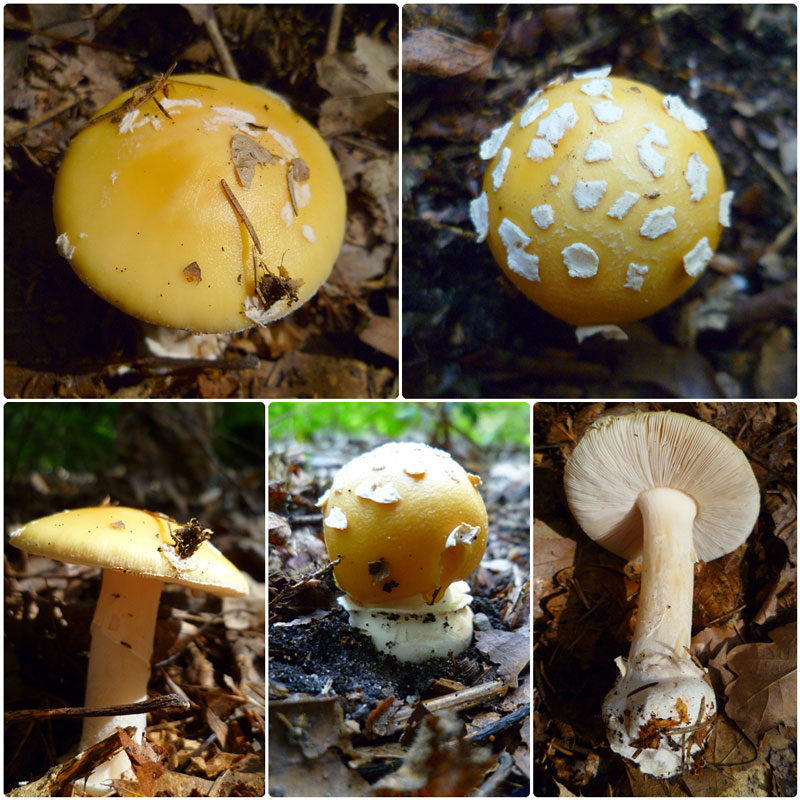
"Amanita gemmata in different stages of development" by is licensed under CC BY 3.0
Amanita gemmata is an evil sister of Amanita muscaria, or Fly Agaric. It has a yellowish cap with white spots or warts. The jeweled death cap is found throughout North America and Europe in a variety of woodland habitats. Its name is a pays tribute to the white "warts" as ornaments. This is not a mushroom anyone should play around with. It can be deadly to dogs or humans. Avoid, avoid, avoid.
Inocybe Stellatospora — DEADLY!

Poisonous Inocybe stellatospora mushrooms growing in Sgt. Poopers client's home in Dallas, Texas 10/8/18. Photo by Steve Hall.
Inocybe stellatospora have small, shaggy conical caps, which flatten with age, and can be frayed. They emit a musty or fishy odor, and contain muscarine, a toxic alkaloid compound which is toxic. A few species of Inocybe are hallucinogenic. Symptoms of ingestion include excessive salivation, profuse sweating (in humans), abdominal pain, sickness, diarrhea, blurred vision, labored breathing, and convulsions. Victims with a weakened heart or respiratory problems are more at risk of death. Excessive salivation and sweating can start within 30 minutes of ingestion. The antidote is atropine. Inocybe is a mycorrhizal fungus: underground, Inocybe exchanges nutrients with tree roots in a mutually beneficial relationship with trees.
Clitocybe Dealbata — DEADLY!

Poisonous Clitocybe dealbata mushrooms growing in Sgt. Poopers client's home in Dallas, Texas 9/17/18. Photo by Steve Hall.
Like Inocybe, the most dangerous toxin of Clitocybe dealbata is muscarine which acts like a nerve agent. Within 15 to 30 minutes of ingestion, the first symptoms show up including greatly increased salivation, heavy perspiration (in humans only—dogs don't have sweat glands in their skin), and tear flow . In severe cases, these initial symptoms are followed by violent abdominal pain, nausea, diarrhea, blurred vision, and difficulty in breathing. In humans, symptoms may diminish within two hours. Death (to humans) is caused by heart or respiratory failure but luckily is rare. The specific antidote is atropine.
Non-Deadly Species of Mushrooms in Dallas, Texas
Just because a species of mushroom is not deadly doesn't mean it is "edible" and won't make you very sick. Certain people can have a toxic reaction to a plant that someone else may not have. Mushrooms contain complex chemicals and many harmless mushrooms resemble deadly species so closely only an expert can tell them apart.
Just because you see a photo of a mushroom here, doesn't mean it is safe. As conservationists, we advocate respect for nature. "Respect" teaches us to treat any gun like it's loaded; treat any mushroom like it's deadly.
NEVER EAT ANY WILD MUSHROOM! To be on the safe side, just leave wild mushrooms alone or you can let Sgt. Poopers scoop them up and throw them away.
Phycomyces Blakesleeanus
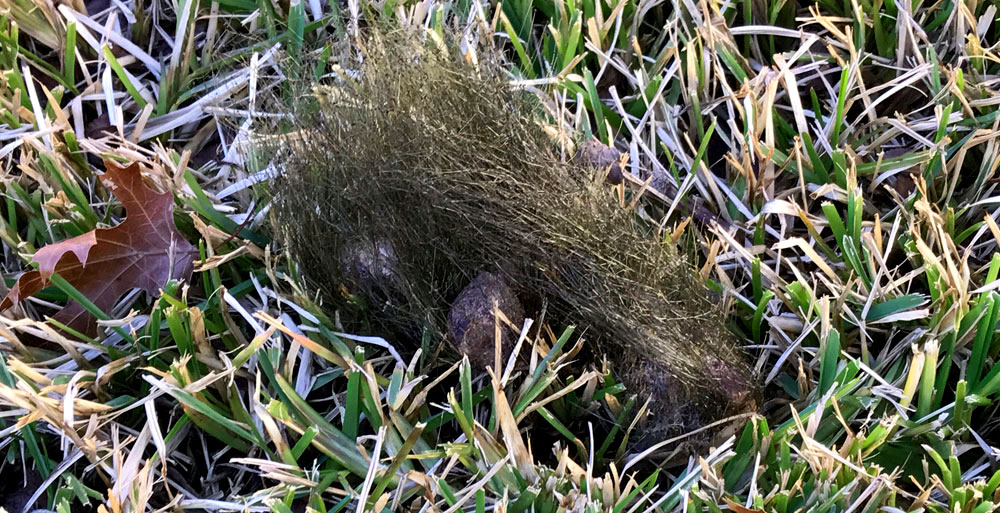
Phycomyces blakesleeanus fungus growing at Sgt. Poopers client's home in Dallas, Texas 12/21/18. Photo by Steve Hall.
Revolting-looking but not highly toxic, Phycomyces blakesleeanus looks like a handful of long black hair pucked from a Sasquatch. Luckily, Phycomyces blakesleeanus produces no known toxins and can commonly seen around Dallas (and across North America) in the fall growing on dog waste. The black hairy filaments grow up to four inches long and are actually reproductive stalks called sporangiophores that bear a single tiny sphere at the tip containing spores. This species of fungi doesn't grow at human body temperature so is incapable of causing any toxic reaction as far as we know. However, as it grows literally out of dog waste, the waste itself can definitely pass on germs.
The photo above is from December 2018, and was taken in one of our client's yards.
The canine process of digestion converts only about half of foodstuffs into calories that support life. The remaining 50% of the potential calories from the food are still in the waste. These calories represent a significant bonanza to organisms that feed on waste including flies, roaches, rats and fungi like Phycomyces blakesleeanus.
Tricholomopsis rutilans, Plums and Custard
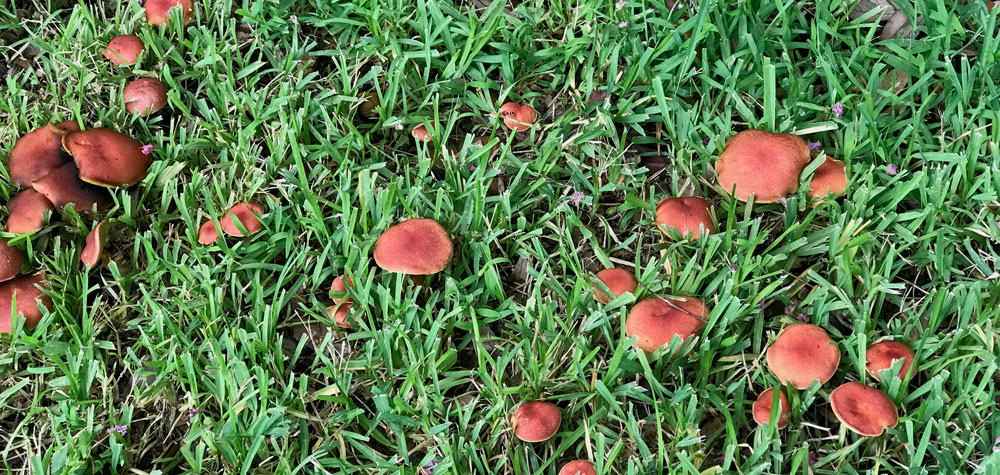
Tricholomopsis rutilans fungus growing at Sgt. Poopers client's home in Dallas, Texas 9/11/18. Photo by Steve Hall.
Tricholomopsis rutilans fungus growing at Sgt. Poopers client's home in Dallas, Texas 9/13/18. Photo by Steve Hall.
The Tricholomopsis rutilans is not poisonous, but not edible either due to its extraordinary bitterness. It is colorful, featuring a spotty red cap, with a custard-yellow underside. It can be found in Dallas backyards, on stumps or over ground containing dead wood such the roots from a dead tree. It has two common names, "Plums and Custard" and "Red-haired agaric."
Pisolithus Tinctorius, Dyemaker's Puffball

Pisolithus tinctorius puffball growing at Sgt. Poopers client's home in Dallas, Texas 10/11/18. Photo by Steve Hall.
About the size of a plumb or baseball, these hardy brown puffballs are extremely tough. They can grow amid rocks and even push themselves up through asphalt. The photo depicts one of several I found in a client's rock bed beside their house in Highland Park, Dallas, Texas. They look like a dark brown ball of clay with pebbles embedded in the outside. Once "ripe" the puff ball breaks open to spill what is generally considered to be harmless cinnamon brown spore power about the area. Known as the dye-maker's puffball, the spores were used for dyeing wool. No known cases of illness have come from ingesting or inhaling the spores.
Hymenopellis furfuracea
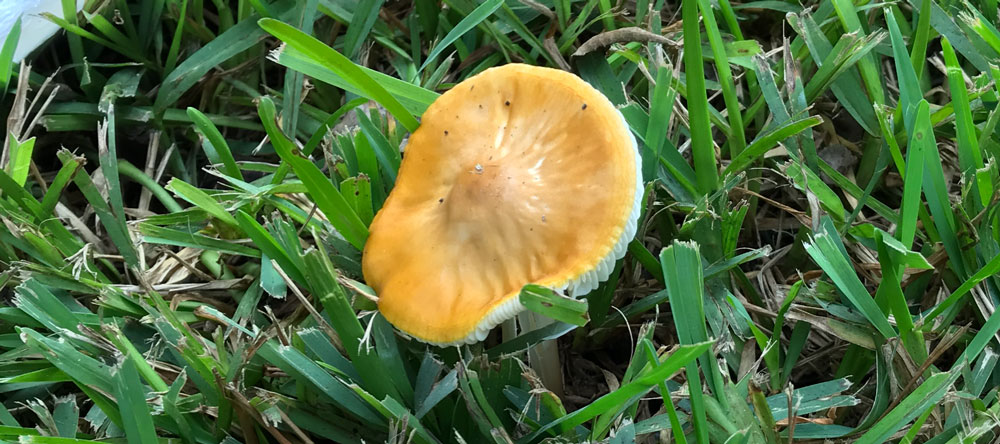
Hymenopellis furfuracea mushroom growing at Sgt. Poopers client's home in Dallas, Texas 10/8/18. Photo by Steve Hall.
This pretty mushroom grows by itself or in a small group over and around the stumps or bases of deciduous trees, or above buried wood. According to text books, this species can be found in North America from May through October and indeed, the photo above was shot October 8, 2018 at one of Sgt. Pooper's client's yards in Dallas, Texas. Hymenopellis furfuracea is harmless but please don't take our word for it. There are more than a million varieties of fungi and this one is similar to deadly versions, like Galerina Marginata, and other toxic versions some of which require a microscope to tell them apart.
Poison Mushroom Control Prices

Poison Mushroom Control Summary

A backyard that hosts deadly mushrooms is no walk in the park! Our poison mushroom protocol is designed to protect and conserve the most precious parkland of all — the one you call home. It’s like having a park ranger for your own backyard which is why we say, “We treat your yard like a National Park!”
Sgt. Poopers is a conservation company, so our protocols are based on the principles of conservation. Our approach is common-sense, holistic, always safe, and 100% effective. Our methodology works and you will see immediate results. On top of everything else, no contract is required. We do not use toxic chemistry that can harm people or pets. We restore the balance of nature and make living environments safe for you, children, pets, and beneficial insects like honeybees and butterflies. Please tour our website to learn more. If you have any questions, please call us today at (214) 563-6379. For your convenience, you may also request services from this site.


Steve Hall
CEO & President, Sgt. Poopers
Conservation Advocate
We would like to thank you for your interest in Sgt. Poopers. We look forward to serving you in the near future!
Proudly serving neighborhoods throughout greater Dallas, Texas
Monday–Friday: 8AM–8PM
Saturday: 8AM–5PM
Sunday: 9AM–8PM
(214) 563-6379
 Satisfaction
Satisfaction
![]() Guaranteed
Guaranteed
Bonded and Insured
11041 Garland Rd, Dallas, Texas 75218 | This email address is being protected from spambots. You need JavaScript enabled to view it.
Questions and Answers for Voice Search
Here are the answers for questions addressed to Alexa, Siri, Cortana, and Google Home.
How do I protect my dog from eating poison mushrooms?
Dallas backyards commonly host several species of highly-toxic mushrooms which can appear overnight. Ingesting any of these poisonous fungi (loosely called "mushrooms") can not only make a human or dog severely sick, eating just one bite can result in irreversible damage to vital organs and even death. Sgt. Poopers can help protect your family and pets by finding and removing suspicious mushrooms each week when we clean. Prices start at just $1.95 for weekly customers. Call (214) 563-6379
Can dogs be poisoned by eating mushrooms?
Dallas backyards commonly host several species of highly-toxic mushrooms which can appear overnight. Ingesting any of these poisonous fungi (loosely called "mushrooms") can not only make a human or dog severely sick, eating just one bite can result in irreversible damage to vital organs and even death. Sgt. Poopers can help protect your family and pets by finding and removing suspicious mushrooms each week when we clean. Prices start at just $1.95 for weekly customers. Call (214) 563-6379
Can my children be harmed by mushrooms in the grass?
Dallas backyards commonly host several species of highly-toxic mushrooms which can appear overnight. Ingesting any of these poisonous fungi (loosely called "mushrooms") can not only make a human or dog severely sick, eating just one bite can result in irreversible damage to vital organs and even death. Sgt. Poopers can help protect your family and pets by finding and removing suspicious mushrooms each week when we clean. Prices start at just $1.95 for weekly customers. Call (214) 563-6379
Is there a service that removes poison mushrooms?
Dallas backyards commonly host several species of highly-toxic mushrooms which can appear overnight. Ingesting any of these poisonous fungi (loosely called "mushrooms") can not only make a human or dog severely sick, eating just one bite can result in irreversible damage to vital organs and even death. Sgt. Poopers can help protect your family and pets by finding and removing suspicious mushrooms each week when we clean. Prices start at just $1.95 for weekly customers. Call (214) 563-6379
- Sgt. Poopers Conservation Rangers provide soil testing for contaminates and for nutrients across Greater Dallas
- Sgt. Poopers provides all-natural non-toxic pest control in Dallas, Texas starting at just $11.95 a week.
- Learn more about our conservation work.
Tags: environmental toxins, toxin control, poison mushrooms, toxic fungi, toxic mshrooms, dangerous mushrooms

